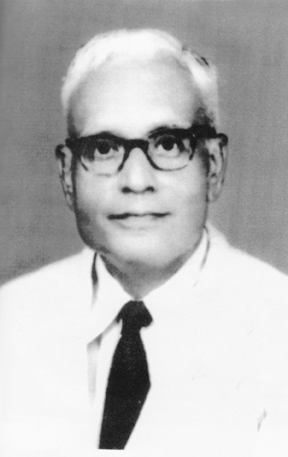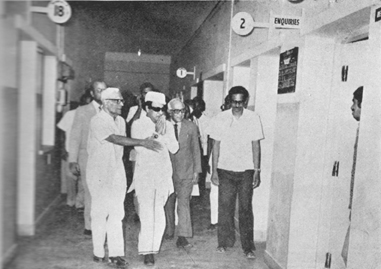|
(Continued from last fortnight)
M.C. Subrahmanyam, Editor, The Indian Review, and Hony Secretary, Public Health Centre (PHC), West Mambalam, wrote in the 1970s, “VHS today is an example and an inspiration in the field of voluntary medical service, silently beckoning medical men of quality to spare a portion of their time for service to the community... There may not be a record to show all the sources Dr. Sanjivi tapped to build and maintain this new experiment in community medical service: the sources that yielded readily, those that yielded but with a lot of pontifical advice, those that remained ice cold, those that gave out insult and nothing more, and those who were more vain than compassionate. It may not also be known how Dr. Sanjivi bent over backward to provide all facilities to medical men of high academic distinction in some of the rare specialities. VHS is a monument to the services of a fragile man with a flaming will!”
Dr. C. Raghavachari noted, “The establishment and smooth running of the Voluntary Health Services called for organising capacity, administrative skill, diplomacy, delegation and capacity to develop good public relations with staff, co-workers, agencies and the public at various levels. The magnitude of the task and the pace of the execution called for a great sacrifice of comfort and leisure.”
Dr. J. Balasubramaniam recalls that on ward rounds Dr. Sanjivi was always kind to patients and soft-spoken and encouraged keen discussions among students. Even in the most difficult cases, he never antagonised anyone, whether colleague or patient. A smiling utterance of Saappaatturama or Pythiakkaran was a rare admonition!
The man they were referring to was Dr. K.S. Sanjivi whom many consider “the father of the primary health care movement in India”.

Dr. K.S. Sanjivi.
Sanjivi passed out of Madras Medical College in 1927, and went on to complete his MD in General Medicine (one of the first four to do so!).
From his first posting at the Kilpauk Mental Hospital, he moved to Madurai in the mid-1930s to work at the Government Erskine Hospital. Later, at the Royapettah Hospital he was in charge of the TB Ward and allergy clinic, before moving to the General Hospital as RMO in 1946. In 1947, he trained in the UK and USA and on his return in 1948 was appointed Director of the TB Research Centre at Chetpet, and Director of the TB Sanatorium, Tambaram. When he was appointed Professor of Medicine at Madras Medical College, he was to enjoy the best years of his government service. With meticulously planned classes and a subtle sense of humour, he built up a rapport with his students that lasted throughout his life. He strongly felt the need for senior doctors to encourage younger colleagues even at expense of their own careers. The tremendous affection his students held him in paid rich dividends later when he started the VHS.
Dr. B. Ramamurthi, the acclaimed neurosurgon, once wrote, “In 1957, when Dr. Sanjivi was to become the Chief Executive of the Madras Medical College, that was denied him on irrelevant grounds, he resigned and the episode was a blessing for the people of Madras and for the people of India. The idea of VHS was born and so was the message of ‘people helping themselves towards better health’. His idea of small voluntary contributions from the poor and his concept of preventive and promotive health have influenced the delivery of health care in our country.”
Well-known physician Dr. K. V. Thiruvengadam recalls, “The privilege (he had) of being his student in the clinical years, a postgraduate trainee with him, and his Assistant Physiscian – all over a period spanning nearly ten years. Very few clinicians would be so sedate, yet so sharp and quick of reflexes, reticent, yet so effective in clinical discussions, soft spoken and yet so reassuring to their patients!”
Dr. Sanjivi’s advice to students was to be simple and frugal in all their actions, never to over-prescribe, never to over-investigate and to always be kind to patients! Dr. Saroja Srinivasan, who joined VHS in 1966 as the RMO, remembers accompanying him on his medical rounds, visiting about 25 patients over two hours, “His clinical acumen was so exceptional that he rarely relied on lab tests or X-rays, and always prescribed simple drugs. His recall memory was brilliant and he’d often quiz us about instructions given on patient follow-ups weeks earlier! Particular about not wasting any resource – power, water or paper – tests that had to be done were indicated on a small slip of paper with the VHS stamp. Meticulously he’d note down points for the day in between meetings with colleagues/patients, on a small piece of recycled paper with a neatly sharpened pencil that would be used to the last remnant!” And Dr. S. Raghavachari, who had a long association with Dr. Sanjivi from P S High School to medical service and, post-retirement, at VHS, speaks of “two entirely different phases of his life – “one before preponed retirement, a quiet and placid life as a physician and teacher of medicine with academic achievements, and the other after retirement, a life of restless, dynamic activity in the fulfilment of a stupendous, self-imposed mission in life., a brilliant innings!”
Polite and gentle in speech and manners, he emphasised the moral responsibility of well-to-do citizens to help poorer sections. Dr. Sanjivi was greatly influenced by Gandhian thought and, therefore, the underlying ethos of VHS has been prevention and cure of serious illness, fostering of the family as a unit for medical care, and facilitating active community participation in the provision of a continuum of healthcare, with special reference to disadvantaged groups such as women, children and elderly.
To ensure this was his “genius for mobilising support for his cause, and the way he got initial help from the Race Club by individually contacting and canvassing support from the hundred-odd members with different interests and moods.”
Dr. Krishnamoorthy Srinivas often speaks of how he once took Dr. Sanjivi to meet a rich industrialist who kept his legs stretched out on a table throughout the conversation! When Dr. Srinivas apologised later for his friend’s bad manners, Dr. Sanjivi replied, “Oh that’s nothing...I would not have minded even if he put his legs on my head as long as he gave a sizeable donation.” Dr. J. Balasubramanian recalls an instance when Dr. Sanjivi learnt that a donor had given a cheque for Rs 40,000. “It was found out that the donor lived on C V Raman Road, and he went to visit him to thank him. He came back smiling with another Rupees 2 lakh donation for the VHS!” Dr. Sanjivi’s unassuming and easily approachable personality made him one of the best public relations men in the city! From well-known consultants to ward boys, he motivated them all to have a sense of ownership for VHS.

The then Chief Minister M.G. Ramachandran being shown around the VHS
hospital by Dr. K.S Sanjivi.
For a man of his achievements, the greatest quality and strength he possessed was to retain his humility and give others the credit. Dr. C. Raghavachari once said of him, “Short in stature, frail in constitution and with low voice, but with the best inner strength and will power to succeed in areas where most people would be unsuccessful. An inspirational force, initially it was his gentle but determined and persuasive manner that spurred people on. His larger than life persona continues to envelop the campus, willing professionals to continually develop services for the less privileged sections of society.”
Thilakam, at present a Blood Bank Assistant, VHS, grew up “like a daughter” in the doctor’s household from the age of 12. She recalls that Dr. Sanjivi was disciplined in his eating habits and daily routines. His weight was always a standard 50 kg and, till the time he stopped driving, he always drove at a sedate 40 km/hour..Even in his seventies, he would take the stairs in the VHS and never use the lift! His respect for everyone he met was well-known, cutting across religions and among of cross-sections of society.
Following his wife’s death in 1980, Dr. Sanjivi threw himself even more into building up VHS. By mid-1989, be suffered a series of strokes that left him bedridden and blind. Yet he continued to be active, discussing cases with doctors and taking classes in hospital administration. On October 1, 1994, he breathed his last. As his daughter Gita wrote, “A calm and peaceful ending to a life of cheerful and unselfish service.” He was the recipient of many honours and awards: the Padma Shri in 1971, the Padma Bhushan in 1976, Dr B C Roy National Award for Socio Medical Relief in 1976 and many others. But to him the implementation of his messages meant more than any award.
(To be Concluded)
|

